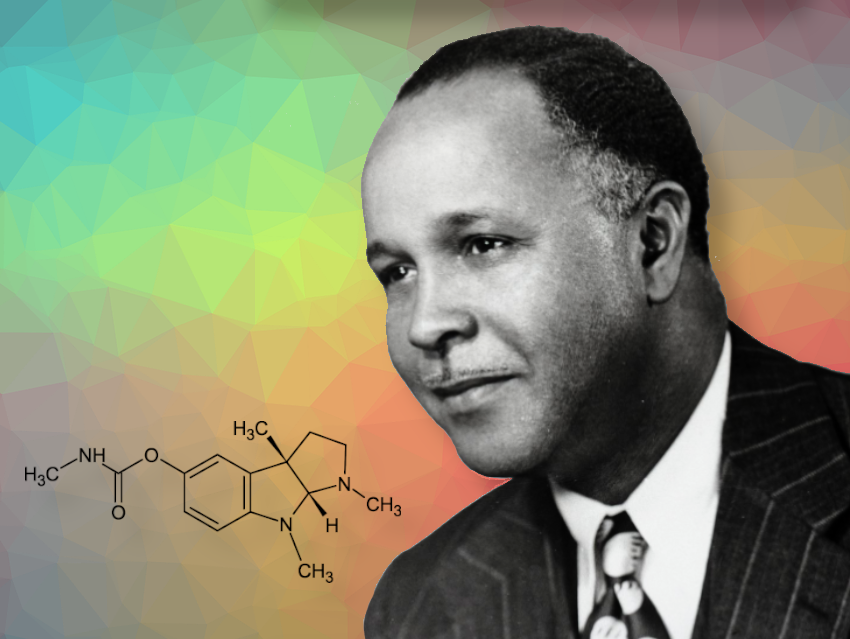He’s been referred to as a “pioneering chemist,” a “forgotten genius,” and “the man who wouldn’t give up.” The achievements and breakthroughs of Percy Lavon Julian, the African American organic chemist who overcame every barrier to become a pioneer in his field, are not only remarkable in a scientific context, but also on a human level. In a profession whose traditional path is paved with clear milestones, Percy Julian blazed his own trail, creating opportunities where there seemingly were none, and never losing sight of his dreams and ambitions.
Family and Education
In a way, Percy Julian’s life and career were defined by the hurdles that were repeatedly set before him, as each one he conquered only fuelled him to take on the next. This outlook was instilled in him from an early age. Born in 1899 in Montgomery, Alabama, a focal point of the civil rights movement in the U.S.,Julian already had a legacy of education to live up to. His grandfather had had two fingers cut off for learning to read and write while he was a slave, while Julian’s parents were schoolteachers and invested in books for their children during a time when blacks had no access to public libraries. Reading about science introduced Julian to the wonders of chemistry, walks in the woods with his father inspired his specific attention on natural products chemistry.
This passion for learning helped him to get all the way to university, even when there weren’t any public high schools for black children in the South. While taking remedial classes in addition to the university curriculum to make up for the gap in his education, as well as working as a servant in a fraternity house to be able to live in its attic, Julian not only successfully graduated from DePauw University, Greencastle, IN, USA, he was also the class valedictorian.
Despite this unprecedented accomplishment, Julian went on to face a whole new set of challenges in his academic career. He taught at Fisk University, Nashville, TN, a black university, for several years before finally getting an opportunity to earn a master’s degree in chemistry at Harvard University. But going on to pursue a doctorate there was stopped short by the institution’s unwillingness to allow a black student to take a teaching assistant position. He went back to teaching at black universities and even became the chair of the chemistry department at Howard University, Washington, DC, before a new door opened – a Rockefeller fellowship that enabled him to go to Europe to get his doctorate.
Vienna Calls
Julian chose to study at the University of Vienna, Austria, based on his familiarity with the renowned chemist Ernst Späth’s work with alkaloids. Späth tasked Julian with isolating and identifying the active ingredient in the root of Corydalis cava, a common Austrian shrub, which was known to be effective in treating pain and heart palpitations. Späth was so impressed by Julian’s determination and success in this assignment that he later described Julian as “an extraordinary student [whose] like I have not seen before in my career as a professor.”
Julian quickly proved to be a star in the lab: he arrived without fail at 7:55 every morning and was noted for his neatness. He had crates of ground glassware shipped in from the U.S. that instantly upgraded the Interwar university lab, where such fancy equipment was scarce. His charm and good humor made him popular among the other students, both in and out of the lab, where he enjoyed an unfettered social life for the first time. One fellow student, Josef Pikl, whom Julian brought back with him to the U.S. later on, described Julian’s time in Vienna as “having a great influence in developing [his] personality. For the first time in his life, he was completely at ease, no open or hidden barriers, really an equal among equals.”

A Bold Move
After this crucial period of personal development and finally earning his doctorate, Julian returned to the U.S. in 1931. After a few fits and starts at a number of universities, encountering both familiar and new limitations on his academic career, he decided that he had to tackle a project that “would make people take notice of” him: the synthesis of an alkaloid called physostigmine (pictured on the right), used to treat glaucoma, which had not been successfully done up to that point. With Pikl as his assistant, he published a series of papers on the progress of his work in the Journal of the American Chemical Society [1–5].
With this synthetic target came also the next potential hurdle to Julian’s mission: Sir Robert Robinson (University of Oxford, UK), perhaps the leading organic chemist of the time, had also been working towards a total synthesis of physostigmine and had already published a series of papers on it. Hence began a race to see who could be first to claim victory. Eventually, a point was reached where Julian noticed inconsistencies in Robinson’s results and set out to correct them – a gamble which could effectively end his career, if he were wrong.
The challenge hinged on the synthesis of a compound residing one step away, in the synthetic pathway, from the final target: Eserethole. Julian’s Eserethole exhibited entirely different properties from Robinson’s, and the claim of Julian’s final paper was that his was the correct compound while Robinson’s was not. Dramatically, the final proof of this claim depended on demonstrating melting point equivalence to the natural one – something Robinson’s Eserethole did not display.
The gamble ultimately paid off: Julian received international acclaim for his successful total synthesis of physostigmine. This achievement was eventually acknowledged by the American Chemical Society as a milestone in the history of chemistry, and it would have normally not only secured a chemist’s place on the professional landscape, but also guaranteed an open path to the heights of a scientific research career, i.e., a faculty position and professorship.
Ongoing Battles
Regretfully, even this breakthrough did not curtail Julian’s battle with discrimination in the academic arena, as he continued down the obstacle course of his professional journey. Unable to get an academic appointment, Julian turned towards industry. Even his colleague Pikl was offered a position before Julian at DuPont, where they had both interviewed. An offer from the Institute of Paper Chemistry proved untenable as the town where it was located did not permit blacks to be housed overnight there.
But Julian continued to defy all odds and went on to become a genuine pioneer in the chemical industry. As the Director of Research at the Glidden Company, a paint manufacturer, his work in the soy product division led to groundbreaking developments in the mass production of progesterone and cortisone. He then went on to found his own company, where he hired many fellow black chemists. In his lifetime, he was granted more than 130 patents and published over 160 papers.
Despite all this, the shadow of discrimination never quite dissipated. After achieving enough security to buy a house for his family in the prestigious Oak Park neighborhood in Illinois in 1950, it was firebombed right before they moved in, prompting him to become more involved in the Civil Rights Movement in his later years.
In an unfinished autobiography, Julian reflected on his career [6]:
“I feel that my own good country robbed me of the chance for some … great experiences. Instead, I took a job where I could get one and tried to make the best of it. I have been, perhaps, a good chemist, but not the chemist that I dreamed of being.”
This article was written and researched with the support of a Research and Journalism Stipend from the Austrian Academy of Sciences and consultation on technical details from Dr. Nuno Maulide, Dean of Organic Chemistry at the University of Vienna, Austria.
References
[1] Percy L. Julian, Josef Pikl, Studies in the Indole Series. I. The Synthesis of Alpha-Benzylindoles, J. Am. Chem. Soc. 1933, 55(5), 2105–2110. https://doi.org/10.1021/ja01332a054
[2] Percy L. Julian, Josef Pikl, Doyle Boggess, Studies in the Indole Series. II. The Alkylation of 1-Methyl-3-formyloxindole and a Synthesis of the Basic Ring Structure of Physostigmine, J. Am. Chem. Soc. 1934, 56(8), 1797–1801. https://doi.org/10.1021/ja01323a046
[3] Percy L. Julian, Josef Pikl, Studies in the Indole Series. III. On the Synthesis of Physostigmine, J. Am. Chem. Soc. 1935, 57(3), 539–544. https://doi.org/10.1021/ja01306a046
[4] Percy L. Julian, Josef Pikl, Studies in the Indole Series. IV. The Synthesis of d,l-Eserethole, J. Am. Chem. Soc. 1935, 57(3), 563–566. https://doi.org/10.1021/ja01306a053
[5] Percy L. Julian, Josef Pikl, Studies in the Indole Series. V. The Complete Synthesis of Physostigmine (Eserine), J. Am. Chem. Soc. 1935, 57(4), 755–757. https://doi.org/10.1021/ja01307a051
[6] P. L. Julian, An Autobiography: In the Fantastic Garden of Hope, unpublished manuscript (Percy Lavon Julian Papers, Science History Institute, Philadelphia, PA, 1959).



